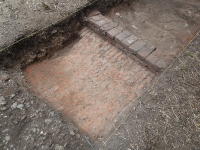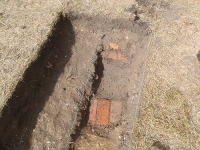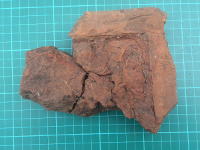14 Jul 2017
Forty Hall Summer Dig - Day 3

Day 3 of the dig saw more very nice Tudor Palace remains emerging, including a larger exposure of the brick surface we only got a glimpse of late yesterday afternoon.
The floor (pictured) is on the east side of the narrow wall in trench 2 and is made of bricks laid edge-on, clearly intended to form a durable surface. It slopes down noticeably away from the wall, although whether this is deliberate, perhaps to aid drainage, or a result of subsidance, we don't yet know for sure.
It also appears as though the floor is less worn at the edge nearest the wall, reinforcing the idea that this surface saw heavy wear and tear during its life.
Interestingly, on the south edge of the exposed floor (top of pic) there is a rectangular gap in the bricks, which has revealed another similar layer of bricks beneath. This may indicate an earlier floor surface, or may be a deliberate feature set in the floor - we will need to extend the trench south to find out more.

Meanwhile, the search for the elusive wall in trench 1 threw a curveball at the last minute, producing not one but two walls, paralell and about a metre apart.
We've only seen three bricks worth of each of these walls so far so it's early to say what they might be, but amongst the possibilities is two sides of the remains of a brick arched drain - always a welcome feature at Elsyng since they frequently contain lots of exciting finds!
Another extension has been laid out to fully uncover this feature and hopefully tomorrow we should get a better idea of what it is.

There were lots of very nice finds today includng decorated pottery, fragments of window glass and the lead that held it in place, and even the carved stone that would have surrounded the windows.
One of the most tantalising finds (pictured) was two joining fragments of a square terracotta plaque, which would quite likely once have formed part of an armorial device, perhaps belonging to Sir Thomas Lovell, who owned Elsyng from about 1490 to 1524, or even Henry VIII himself. Frustratingly, the fragments have either been defaced or possibly have a deliberate rough texture that formed the background to a much larger carving. Either way there is no recognisable detail in the bits we have.